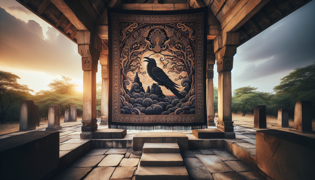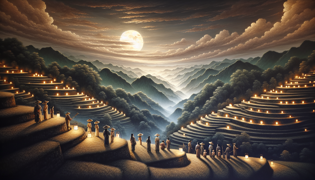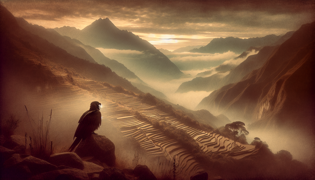Introduction
High in the ancient Andean ranges of Peru, where mist clings to jagged granite peaks and wind carries the fragrance of quinua fields, villagers speak of a rare and solemn messenger called the Achiwawa. No one knows exactly how long its mournful cry has threaded through these valleys, passed down by generations of mountain farmers, shepherds, and priests who understood that every trill carries a warning beyond mortal senses. Elders whisper that the Achiwawa was born when the first condor and the mountain spirit Apus united their voices to protect humankind from hidden calamities. They say this elusive bird nests in crevices wedged between cliffs far beyond the reach of ordinary eyes and vanishes like a memory in the dawn fog. Twice each day—at twilight and before sunrise—its lament weaves through the chill air, a melody of caution heralding floods that surge through narrow ravines or avalanches that break loose on snowbound slopes. Families learn to interpret the length and pitch of each note, comparing it with ancient quipus and embroidered cloths that record past omens. When households hear the distant call, they leave offerings of coca leaves, maize kernels, and chicha beer at the foot of the stone shrine dedicated to the Apus, affirming respect for forces that dwell beyond human sight. From planting season to harvest, the Achiwawa’s warning guides every decision, teaching the rhythms of earth and sky. In this tale, we travel to a humble village perched on a windswept plateau, where the young shepherd Micaela and the skilled farmer Tomas struggle to protect their families from disasters hidden in the folds of granite and snow. It is here, amid terraced fields, sacred shrines, and roaring mountain winds, that the Achiwawa will test their resolve, challenging them to trust a lone call carried on the wind and avoid dangers buried deep under Andean slopes.
The Old Legend of the Achiwawa Bird
Long before modern roads carved ribbons of asphalt through the Peruvian highlands, villagers told stories under the glow of flickering torches, recounting how the Achiwawa first appeared at the birth of the sun. They say an ancient priest, seeking guidance from the Apus—the great mountain spirits—heard an otherworldly cry ring out across a heavy morning mist. He climbed through twisting paths to a hidden ledge, where he found a small, night-black bird with feathers that shimmered faintly like obsidian. Its eyes held the depth of midnight skies, and when it tilted its head to issue a low lament, the priest fell to his knees. For in that single note lay a warning of floods born of spring snowmelt, and earthquakes brewing deep beneath the peaks. Word of the priest’s vision traveled swiftly across knotted trails, carried in whispered prayers and woven tapestries. Each family invited the priest to teach them the bird’s language: how a high-pitched trill signaled falling rocks, and how a drawn-out woeful moan foretold raging waters. Across generations, the villagers perfected this ritual. They carved tiny wooden shrines in the shape of the bird and left offerings of coca and maize husks, ensuring their harvests remained safe and their livestock unharmed. Even children memorized the legend, playing beneath the terraces and imitating the Achiwawa’s call in hopes of awakening its protective spirit. Though none had seen the bird in years, its presence lingered in every rushing creek and in the hush before dawn. To them, the Achiwawa was neither myth nor mere creature, but a guardian bridging the world of stone and the realm of sky.
When Tomas, a young farmer with calloused hands and a heart full of dreams, first heard the story, he was skeptical. How could a bird, so small and so seldom seen, warn an entire village of looming danger? Yet every harvest season, while he and other farmers labored to plant potatoes and quinoa, they noted subtle changes that matched the Achiwawa’s cry. A sudden chill in the air, a trembling in the earth, or the murmur of swollen streams—all arrived days after the villagers heard that mournful call. Soon, Tomas’s doubts gave way to reverence. He would stand at the edge of his terraced field at first light, listening for the slightest echo. If the cry came, he hurried his workers and neighbors to safe high ground, where they built temporary shelters of woven reeds until the ominous season passed. Mothers hushed their children and pointed to the sky, teaching them that nature’s voice, however strange, must be heard with respect. With each life saved and every home spared, belief in the Achiwawa grew stronger. Even the distant Inca administrators who visited the valley recognized the bird’s gift, commissioning flute players to mimic its call and warn travelers of nearby danger. Thus, an ordinary valley became a sanctuary under the wings of an unseen sentinel.

In time, the legend passed beyond the village borders, though few outside ever witnessed the true cry of the Achiwawa. Scholars and travelers returned with stories of cliffs painted in fiery dawn light, where winds carried a solitary plaintive note that stopped hearts with its grief. They spoke of men and women gathering to leave scraps of llama meat and chicha beer on sun-bleached stones, beseeching the bird—though no one knew its nesting place—to sing again if disaster loomed. Some claimed the bird’s lament could even traverse the highest peaks of the Cordillera Blanca, drifting down into distant valleys and sparking ceremonies at lakes sacred to the Apus. Whether drawn by the ritual or by genuine reverence, thousands came seeking an omen. Yet the Achiwawa revealed itself to only a handful, selecting those who listened with humility and devotion. To this day, villagers believe that as long as they maintain the ancient shrines and honor the offering, the Achiwawa’s warning will echo through the Andean heights, guarding each life beneath its mournful wing.
The Mournful Call at Dusk
One autumn evening, when the sun melted behind the peaks in a blaze of copper, the villagers of Pachamarka paused their work to admire the sky’s farewell. Women carried clay pots of chicha back toward thatched roofs while children darted among the terraces, plucking kernels of maize for the communal granary. Suddenly, a hush fell across the valley as a single, low lament echoed from the distant ridges—long, quivering, and impossibly sad. Tomas, who had grown accustomed to the pattern, froze in his path. He knew that cry did not belong to any condor or partridge. It was the voice of their long-lost protector. Alarmed workers dropped tools and gathered on the highest terrace, peering into the gathering dusk haze where the call had come. Across the valley, the priestess Micaela emerged from the shrine, her hands raised as if invoking an ancient covenant. She studied the horizon for the flicker of a black silhouette against the reddening sky.
The sound came again, this time more plaintive and insistent, circling above the village like a phantom. Even the alpacas in distant corrals brayed in alarm and skittishly huddled together. Mothers like Antonia gathered their young close, humming old hymns to calm trembling hearts. Tomas approached Micaela and asked what she discerned. Her voice was calm but grave: the high notes foretold the cracking of earth beneath the riverbeds, and the drawn-out moans promised surging waters fed by melting snows. In that moment, village life shifted from routine to ritual. From every home, people emerged carrying lanterns, blankets, and woven sacks of grain. They marked the path to the old refuge atop Coronado Hill as Micaela led them through narrow lanes paved with river stones.

By the time darkness closed in and lantern glowed like fireflies among the terraces, the villagers had reached the ancient stone circle where their ancestors once watched the stars. From that vantage point, they saw the river canyon shimmer under moonlight, suspiciously silent. For hours they huddled, alert to every distant echo of the Achiwawa’s cry. When morning came, Micaela knelt by a ruined wall and discovered the river had burst its banks during the night, flooding fields and crushing the lowest dwellings. Without the Achiwawa’s warning, dozens of lives and much of the harvest would have been lost. As dawn broke, the survivors raised their lanterns in silent thanksgiving, vowing to renew their offerings and preserve the ancient lore that had saved them once more.
How the Village Was Saved
In the days that followed the flood, the village elders convened beneath the canopy of centuries-old eucalyptus trees, where carved stones formed a silent council chamber. Tomas recounted each note of the Achiwawa’s serenade and how it guided them through night-dark fear to safety. Listeners sat in solemn awe as Micaela demonstrated how to interpret the slight tremble in the bird’s wing-calls, noting that the nearer the sound and the deeper the tone, the closer the danger. They inspected the painted cloths—ancient quipus of colored thread and knots—confirming the patterns matched events recorded generations ago. Inspired by this success, the elders decided to reinforce the mountain shrines with new stones and repaint the murals that had faded beneath sun and wind.
Soon after, Tomas led a small group of volunteers up to the highest ledge known to the local guides, carrying offerings of sweet potatoes, coca leaves dusted in fine ash, and pots of fermented maize chicha. As twilight folded into night, they placed each gift with quiet prayers for continued protection. In return, the wind seemed to swirl more gently, and the temperature settled into a forgiving calm. From that vantage point, they watched peaks and valleys in contemplation, mindful of every rustle in the dark and every distant cry that might signal another trial.

Months later, the riverbeds ran clear and the fields recovered under an azure sky. The new harvest promised abundance, and families celebrated with music and dance in the village plaza. At the height of the festival, as fireflies drifted among torches, a single curious whistle drifted down from the mountain rim. It was not mournful now but brief, like a call of approval, a sign that the Achiwawa had witnessed their devotion and would remain a watchful guardian. In the glow of dancing flames and the applause of grateful villagers, Tomas raised his drink of chicha and toasted the unseen sentinel. He knew then that the bond between people and bird, between earth and spirit, was unbreakable so long as wisdom guided each heedful heart.
Conclusion
In regions where mountains stretch toward the heavens and every breeze carries the memory of stone, the Achiwawa bird lives on in both legend and reality as a guardian of souls. Its mournful call became the language of survival for the people of one remote valley, teaching them that true wisdom often hides in the hush that follows a single, haunting note. Today, those terraced fields still cling to the slopes, and shrines etched with ancient symbols face the rising sun as tokens of gratitude. New generations learn the old songs and carry woven cloths inscribed with the bird’s melody, passing the lessons onward like heirlooms. Each year, when autumn hues paint the peaks in fire, villagers pause at dusk, listening for a faint lament that might beckon them home. In honoring the Achiwawa’s warning, they honor the mountain spirits themselves, ensuring that the fragile harmony of nature endures for all seasons yet to come. Thus, the bond forged between human heart and wild spirit becomes a timeless reminder that survival depends not on mastery of the land, but on respectful attention to its subtle voices—voices that speak not in words, but in cries carried on the wind and woven into the fabric of community history.
This tale endures in every whispered warning before a storm, in every shared feast beneath the stars, and in the steadfast hope that, when danger stirs unseen, a solitary cry will once again shine a path to safety through the silent heights of the Andes. It is in that ancient bond—between the villagers, the mountain gods, and the elusive Achiwawa—that we find a lesson for all ages: to listen, to honor, and to believe in the wisdom encoded in every crest and valley of this living world.


















